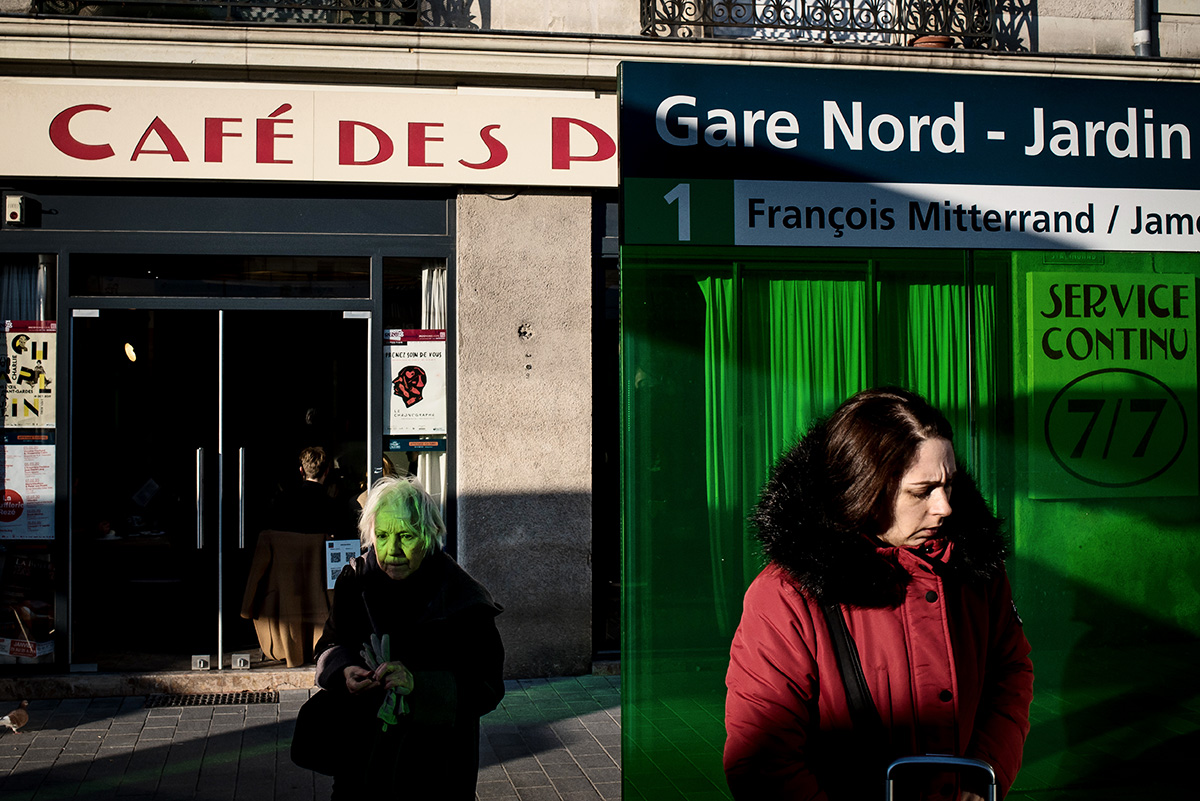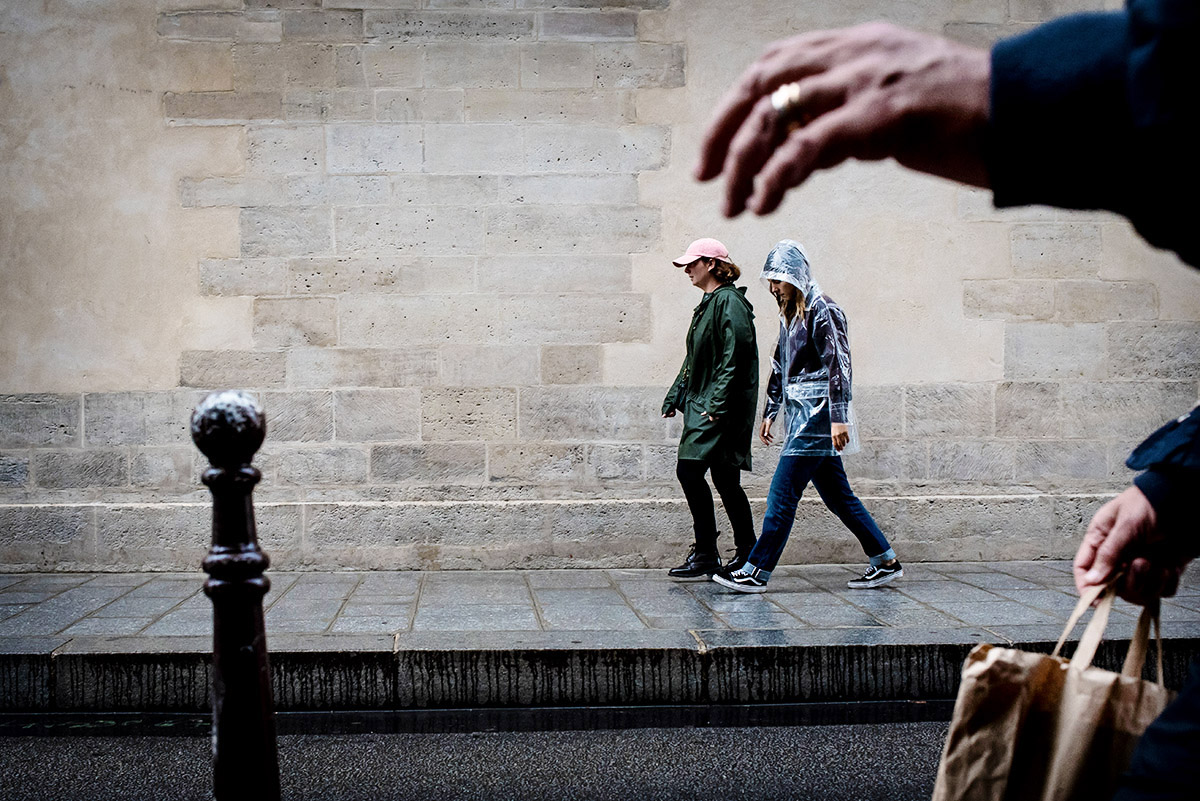At the end of my Brussels Street Photography workshop I posted my top ten photos from there on Instagram. I was pleased to get a like from Matt Stuart, not least because I’d participated in his workshop in the same city back in 2018, and while I’d thoroughly enjoyed the experience, I was not particularly content with the pictures taken.

He also wrote a comment highlighting the image above and the unusual shadow cast on the art folder. I felt rather equivocal about him singling out this shot for praise, as I hadn’t seen the shadow when pressing the shutter and had not paid special attention to it thereafter when seeing the final photo.
LADY LUCK
Basically, I had got lucky. Whereas the other nine shots in my selection, were all, more or less, constructions of a pre-visualised moment, this one, owed its singular impact, according to MS, to the one element I hadn’t accounted for. Although I could appreciate the virtues of my picture, I was less inclined to “own” it, or value it in the same way as my other images.
While I had positioned myself to capture the opposing directions of the road sign and the woman crossing, and had anticipated the lively clash of colours, my eye had not detected the very feature of the image that lifts it beyond a fairly standard juxtaposition. This elongated shadow is what Barthes would refer to as the photograph’s punctum – “that accident which pricks me.”
When I talk about “owning” a picture or attributing a sense of personal worth, I feel inclined, as a keen sports fan, to make a football-related analogy. Surely there is a difference between bending the perfect free kick around a wall into the top right-hand corner ( à la Léo Messi !) and having the shot deflect off the wall, deceive the keeper and trickle into the opposing corner of the net. The outcome- a goal scored, remains the same, but the sense of individual accomplishment is not the same.

Scene potential vs Real-time viewing
Let me offer up another example of my work to further explore the notion of chance in street photography.

Ever since the renovation of Nantes train station and the concourse outside, I had been intrigued by the green glass structures at the tramway stop and the potential for capturing interesting plays of light. As I spotted this foreground woman in red, illuminated by the crisp winter rays, I snapped a few frames and moved in closer. The lettering of the café behind, gave me another element to focus on and structure my picture around. I then noticed a person entering the left side of the image and realized that this would create a more interesting (counter) balance in the picture. However, when I actually fired the shutter with my eye glued to the viewfinder, did I really notice that she would be cast in green light? I can’t remember with any certitude, so while I am very pleased with the outcome, I’m not totally convinced I can take all the credit.
The rough and the smooth – going with the flow
Is it really though helpful or even relevant to adopt what might be referred to as this “holier than though” attitude? Surely there is so much flux taking place in the urban environment that it is nigh impossible to control a hundred per cent, what ends up in the final frame.

Can it not also be argued that when shooting on the streets involves so much frustration, near misses and even bad luck (a perfect frame ruined by someone entering the frame at the last second), it is only reasonable to thankfully accept the bit of good fortune that occasionally steps one’s way. I do agree that being as much as possible in the right place at the right time is the underlying challenge, and then happenstance can play its role. To use another sporting reference, Gary Player the successful South African golfer, who certainly experienced roughs and smooths in more ways than one, famously opined “the more I practice, the luckier I get”.
Graphic minimalism
Maybe it’s my particular style of Street Photography that straitjackets my views on chance outcomes. Heavily influenced by the geometric precision of Cartier-Bresson’s pictures, I have a tendency to limit what I have in my compositions to one or two elements, and therefore control and intention hold primacy in my image creation. I generally avoid scenes where there is a hive of activity all over the place, where everything in the frame has to collide together in one precise moment.

The one way I do sometimes step outside these strict contours is when I try to incorporate movement in an image by using slow shutter speeds. In such cases I’m relying to some extent on the camera’s ability to see differently from my own perception and therefore happy, on such occasions, for good fortune to be one of the deciding factors in creating the picture’s distinctive impact.

The energy and tension of multi-layered images
On a related subject, I am incredibly impressed with the highly creative work of Barry Talis, who uses slow shutter speeds combined with flash photography. His consistently dynamic results show that he knows what he is doing and indeed looking for. He fills the frame from front to back, a burst of colour and vibration, that is enthralling for the spectator.

By the same token, using such complex techniques, it is impossible to fully predict what the final outcome will be. And yet, rather than feeling diminished in any way by the role of luck in the creative process, Talis embraces this aspect of picture-taking in all its free-flowing glory – “I experiment with different light sources for interesting results, I like being surprised when I see how the photo came out.”
Preparation and synchronicity
I would suggest with Street Photography that the amount of luck that one can lay claim to in a picture, is dependent on the degree of importance the role of chance has played in creating the force or primary focal point of interest in the final image. But what may seem a truism to me is not the same for every practitioner of this craft.

When I saw this picture in David Gaberle‘s wonderful book Metropolight, I liked the angle of view, the unusual perspective, the colour harmony, the fact that the focus was unusually placed on the background and not on the waitress. However, it goes without saying that what really caught my attention were the weird lights shining from where the woman’s eyes were supposed to be. This was the punctum that really transformed the image, that gave it it’s unique “reality stranger than fiction” quality. David had not actually noticed this strange reflection phenomenon when firing the shutter, but he still firmly believes he is responsible for creating the picture.
He describes stumbling on the same café where Gueorgui Pinkhassov, a photographer he greatly admires, had taken a trademark intriguing image twenty years previously, as less an act of chance than some pre-destined happening. He took a few frames, inspired by this coincidence and then “at one point, I just looked at the camera and it was as if lightning had struck through my body. I had a photograph that I didn’t even think of trying to capture. The strong feeling of that moment stays with me up till today.”

He goes on to explain: ” quite often, I prefer to discover in my camera a photo already taken. Mostly because I believe the fact that if I already knew it was a good photo while I was making it, I am less likely to learn something new about the world and the nature of photography itself. Of course, there tends to be a certain amount of luck involved. In my native Czech language, there is a saying that “luck comes to those who are prepared”. I don’t think street photographers just stumble upon successful photographs. When I made that image, I had years of practice behind me, I spent hours on the street everyday and all the choices in my life lead me to this point. Rather than luck, maybe, I think of it as synchronicity. Being at the right time and the right place is to me more a matter of preparation and discipline than luck.”
A sense of perspective
I agree with much that David says and certainly believe that the success of a single individual image cannot be reduced simply to the split-second during which light falls on the camera sensor. Claiming credit for luck, as we have seen, can differ from photographer to photographer, in terms of how much they build in chance and happy accidents into their visual approach and shooting method, and also how they define luck itself.
Street photography is also a game. There are, I would claim, some universal rules and others that each individual makes up for themselves. I have argued for example elsewhere that I’m against photographing from the hip, as I feel in basic terms it is being sneaky and not taking responsibility for one’s actions. But maybe my principles are too rigid, maybe it’s time to loosen up a bit.

Intentions v Consequences
To conclude I would like to draw parallels with a fascinating subject I came up against during my university Philosophy studies. Namely moral luck. We intuitively assume that our ethical values are based uniquely on judging intentions and not shaped by factors outside a person’s control. But Thomas Nagel and Bernard Williams challenged the consistency and integrity of this view.

We might, for instance, judge a drunk driver who kills a child (call him the “unfortunate driver”) more harshly than one who does not (call him the “fortunate driver”), even if the only significant difference between the two cases is that a child happened to be playing on the road at the wrong point on the unfortunate driver’s route home. In other words, it’s the consequential good or bad luck that intrudes to inform our judgements.
Similarly, with photography, the judgments we make about luck are neither black or white and can sometimes be counter intuitive. I do generally believe that the harder you work, the more discipline you apply to the craft of street photography, the more you create your own luck and are deserving of such presents when delivered from on high! This does not preclude me holding the view that happy accidents remain happy accidents, and that owning up to such fortunate outcomes, places the value on luck and not some inherent skill.

